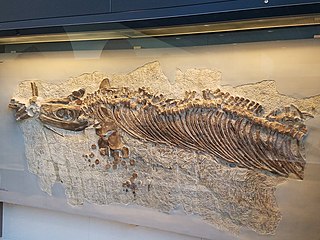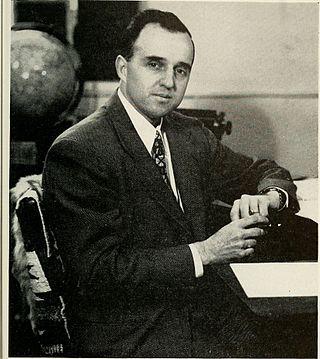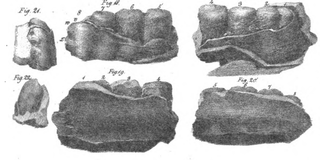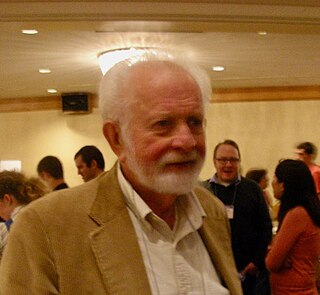Related Research Articles

Dilophosaurus is a genus of theropod dinosaurs that lived in what is now North America during the Early Jurassic, about 186 million years ago. Three skeletons were discovered in northern Arizona in 1940, and the two best preserved were collected in 1942. The most complete specimen became the holotype of a new species in the genus Megalosaurus, named M. wetherilli by Samuel P. Welles in 1954. Welles found a larger skeleton belonging to the same species in 1964. Realizing it bore crests on its skull, he assigned the species to the new genus Dilophosaurus in 1970, as Dilophosaurus wetherilli. The genus name means "two-crested lizard", and the species name honors John Wetherill, a Navajo councilor. Further specimens have since been found, including an infant. Fossil footprints have also been attributed to the animal, including resting traces. Another species, Dilophosaurus sinensis from China, was named in 1993, but was later found to belong to the genus Sinosaurus.

Annie Montague Alexander was an explorer, naturalist, paleontological collector, and philanthropist.

John Campbell Merriam was an American paleontologist, educator, and conservationist. The first vertebrate paleontologist on the West Coast of the United States, he is best known for his taxonomy of vertebrate fossils at the La Brea Tar Pits in Los Angeles, particularly with the genus Smilodon, more commonly known as the sabertooth cat. He is also known for his work to extend the reach of the National Park Service.

Macrofossils, also known as megafossils, are the preserved remnants of organic beings and their activities that are large enough to be visible without a microscope. The term macrofossil stands in opposition to the term microfossil. Microfossils, by contrast, require substantial magnification for evaluation by fossil-hunters or professional paleontologists. As a result, most fossils observed in the field and most specimens are macrofossils. Macrofossils come in many varieties and form in various ways depending on their environment and what is being fossilized including plant, fungi and animal remnants.

Cymbospondylus is an extinct genus of large ichthyosaurs, of which it is among the oldest representatives, that lived from the Lower to Middle Triassic in what are now North America and Europe. The first known fossils of this taxon are a set of more or less complete vertebrae which were discovered in the 19th century in various mountain ranges of Nevada, in the United States, before being named and described by Joseph Leidy in 1868. It is in the beginning of the 20th century that more complete fossils were discovered through several expeditions launched by the University of California, and described in more detail by John Campbell Merriam in 1908, thus visualizing the overall anatomy of the animal. While many species have been assigned to the genus, only five are recognized as valid, the others being considered synonymous, doubtful or belonging to other genera. Cymbospondylus was formerly classified as a representative of the Shastasauridae, but more recent studies consider it to be more basal, view as the type genus of the Cymbospondylidae.
Plotosaurus is an extinct genus of mosasaurs who lived during the Upper Cretaceous (Maastrichtian) in what is now North America. Only one species is recognized, P. bennisoni, described by Berkeley paleontologist Charles Lewis Camp in 1942 from fossils discovered in California. Originally named Kolposaurus, it was changed to Plotosaurus in 1951 when Camp discovered that the name had already been assigned to a type of nothosaur. Unlike other mosasaurids, Plotosaurus possesses a morphology converging with those of ichthyosaurs, suggesting a much more advanced swimming adaptation than some of its close relatives.

Hydrotherosaurus is an extinct genus of elasmosaurid plesiosaur from the Upper Cretaceous Moreno Formation of Fresno County, California, USA. The only known species, H. alexandrae, was named for Annie Montague Alexander in 1943 by Samuel Paul Welles.

Charles Whitney Gilmore was an American paleontologist who gained renown in the early 20th century for his work on vertebrate fossils during his career at the United States National Museum. Gilmore named many dinosaurs in North America and Mongolia, including the Cretaceous sauropod Alamosaurus, Alectrosaurus, Archaeornithomimus, Bactrosaurus, Brachyceratops, Chirostenotes, Mongolosaurus, Parrosaurus, Pinacosaurus, Styracosaurus ovatus and Thescelosaurus.

Charles Lewis Camp was an American palaeontologist and zoologist, working from the University of California, Berkeley. He took part in excavations at the 'Placerias Quarry', in 1930 and the forty Shonisaurus skeleton discoveries of the 1960s, in what is now the Berlin-Ichthyosaur State Park. Camp served as the third director of the University of California Museum of Paleontology from 1930 to 1949, and coincidentally as chair of the UC Berkeley Paleontology Department between 1939 and 1949. Camp named a number of species of marine reptiles such as Shonisaurus and Plotosaurus, as well as the dinosaur Segisaurus.

Phytosaurus is a dubious genus of extinct parasuchid phytosaur found in an outcrop of the Keuper in Germany. Phytosaurus was the first phytosaur to be described, being done so by Georg Friedrich von Jaeger in 1828. The type species is P. cylindricodon and a second species, P. cubicodon, is also known.

The University of California Museum of Paleontology (UCMP) is a paleontology museum located on the campus of the University of California, Berkeley.
Kevin Padian is an American paleontologist. He is Professor of Integrative Biology at the University of California, Berkeley, Curator of Paleontology, University of California Museum of Paleontology, and was President of the National Center for Science Education from 2007 to 2008. Padian's area of interest is in vertebrate evolution, especially the origins of flight and the evolution of birds from theropod dinosaurs. He served as an expert witness for the plaintiffs in the Kitzmiller v. Dover Area School District trial, and his testimony was repeatedly cited in the court's decision.

Aphrosaurus was an extinct genus of plesiosaur from the Maastrichtian. The type species is Aphrosaurus furlongi, named by Welles in 1943. The holotype specimen was discovered in the Moreno Formation in Fresno County, California in 1939 by rancher Frank C. Piava. A second specimen - LACM 2832 - was also found in the same formation and initially diagnosed as a juvenile of the same species, but has since been removed from the genus.

Thalattosaurus meaning "sea lizard," from the Attic Greek thalatta (θάλαττα), "sea," and sauros (σαῦρος), "lizard," is an extinct genus of marine reptile in the family Thalattosauroidea. They were aquatic diapsids that are known exclusively from the Triassic period. It was a 2–3 metres (6.6–9.8 ft) long shellfish-eating reptile with paddle-like limbs and a down-turned rostrum occurring in the Lower and Middle Triassic Sulphur Mountain Formation of British Columbia as well as the Upper Triassic Hosselkus Limestone of California. It has gained notoriety as a result of studies on general diapsid phylogeny.

William Alvin Clemens Jr. was a paleontologist at the University of California at Berkeley. He was faculty of the Department of Paleontology from 1967, then the Department of Integrative Biology from 1994 to his retirement and curator of the UC Museum of Paleontology. Clemens was also director of the museum (1987–1989) and chair of the Department of Paleontology (1987–1989). He was awarded a Guggenheim Fellowship (1974–75), a U.S. Senior Scientist Award by the Alexander von Humboldt Foundation, the Romer-Simpson Medal (2006), and was made a Fellow of the California Academy of Sciences.

Frank Elmer Peabody, was an American palaeontologist noted for his research on fossil trackways and reptile and amphibian skeletal structure.
Bolortsetseg Minjin is a Mongolian paleontologist known for her work in fossil repatriation and dinosaur-themed science outreach. She is a recipient of the WINGS WorldQuest Women of Discovery Award for Earth, National Geographic Explorer, and TEDx speaker. She is the founder of the Institute for the Study of Mongolian Dinosaurs.

Chester Stock was an American paleontologist who specialized in the Pleistocene mammalian fauna of the Rancho La Brea tar pits. He served as a professor of geology at the California Institute of Technology, Pasadena.

The Saurian Expedition of 1905 was a paleontological research mission in northern Nevada in the United States. The expedition recovered many of the most well-preserved specimens of ichthyosaur ever found. Information on the key contributors, details on the expedition itself and its findings can be found below.
The Fossil Hill Member is a Middle Triassic-aged rock unit. The Fossil Hill unit occurs as a member of both the Prida and Favret formations. It outcrops in multiple locations across Northwestern Nevada including the western Humboldt Range, Tobin Range, Augusta Mountains, and China Mountain. Calcareous shale, mudstone, and black limestones are the most common lithologies present within the unit. The member was named for Fossil Hill, Nevada, a locality within the Humboldt Mountains where large quantities of Anisian-aged marine fossils were discovered in the early 20th century. Fossils are common throughout the Fossil Hill, and the unit is well known for preserving the remains of some of the earliest marine reptiles, including several genera of ichthyosaurs and a pistosaur. Other fossils include bony fish, hybodont sharks, and invertebrates with ceratitid ammonoids being especially abundant.
References
- 1 2 3 4 "The Saurian Expedition of 1905 participants". ucmp.berkeley.edu. Retrieved 2020-01-31.
- Mark, Steve (2005-03-14). Preserving the Living Past: John C. Merriam's Legacy in the State and National Parks . University of California Press. p. 86. ISBN 9780520931060.
furlong.